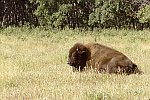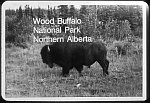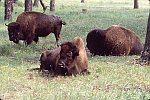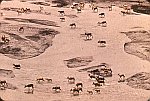Wildlife Management in Canada
Author: Anne Mease Page 1 | Page 2 | Page 3
Endangered, Threatened and Extinct Species
Endangered and threatened species are birds, animals, and plants that are on the verge of becoming extinct. Specially protected mammals, amphibians, reptiles, invertebrates, or specially protected birds cannot be hunted in Canada for any reason.There are currently '280' species listed as becoming extinct in Canada but that number is estimated even higher at about '8000' species at risk.[29]
The main reasons for animals, fish, and plants to become endangered or threatened is due to the destruction of their natural environment, habitat, and wetlands caused by human development of the land through agriculture, urban development, and pollution. Even trails made for walking and hiking can be potentially destructive to the habitat . In Canada, "it is estimated that natural habitat in Canada is being lost at a rate of 240 hectares every hour."[30]
In Canada, the following wildlife, fish, and plants have become extinct
| Common Name | Latin Name | Category | Date of Extinction | Probable Cause of Extinction |
| Caribou - dawsoni subspecies | Rangifer tarandus dawsoni | Mammal | 1920s | Past unregulated hunting |
| Mink, Sea | Mustela macrodon | Mammal | 1894 | Past unregulated hunting |
| Great Auk | Pinguinus impennis | Bird | 1844 | Past unregulated hunting |
| Labrador Duck | Camptorhynchus labradorius | Bird | 1875 | Past unregulated hunting, habitat alteration |
| Passenger Pigeon | Ectopistes migratorius | Bird | 1914 | Past unregulated hunting, habitat alteration |
| Deepwater Cisco | Coregonus johannae | Fish | 1952 | Commercial fishing, predation by introduced species |
| Longnose Banff Dace | Rhinichthys cataractae smith | Fish | 1986 | Commercial fishing, predation by introduced species |
| Hadley Lake Stickleback (benthic) | Gasterosteus sp. | Fish | 1999 | Predation by introduced species |
| Hadley Lake Stickleback (limnetic) | Gasterosteus sp. | Fish | 1999 | Predation by introduced species |
| Blue Walleye | Stizostedion vitreum glaucum | Fish | 1965 | Commercial fishing, habitat alteration |
| Eelgrass Limpet | Lottia alveus alveus | Mollusca | 1929 | Natural causes |
| Shining Macoun's Moss | Neomacounia nitida | 1864 | Natural causes" [31] |
Protected Species
Bison (Bison bison athabascae)
Both the Wood Bison (Bison bison athabascae) and the Plains Bison (Bison bison bison) are protected under the federal Species at Risk Act (SARA). The Wood bison is found only in Canada in northern British Columbia, Alberta, Northwest Territories, Saskatchewan, and the Yukon. It is estimated that in the early 1800s there were approximately '168,000' bison. By 1957, there were an estimated 200.
Bison became a protected species as early as ' 1877' when their population was drastically reduced to the point of extinction during the height of the fur trade era. Bison were the mainstay of Aboriginal people and the fur traders who required provisions. It is estimated that during the fur trade millions of pounds of bison meat would be traded in one year. Bison was used to make pemmican, a vital food product introduced to the Europeans by the Dene, Cree, and Metis. Pemmican is a non-perishable food made of dried, grounded bison meat, marrow or fat, and small amounts of berries. The pemmican was formed into a flat square and wrapped and preserved in buffalo skin. Archeologists in Saskatchewan recently unearthed perfectly preserved pemmican that is estimated to be about 100 years old.
The largest threat to Wood bison is "disease (anthrax, brucellosis, and tuberculosis), cross-breeding with Plains Bison, and habitat loss through human development, agriculture, and forestry and petroleum resource development." [32] Due to conservation measures the number of bison had increased to '3000' in 1999.
Polar Bear (Thalarctos maritimus)
Polar bears roam the vast lands of the Canadian Artic as well as other areas in the Circumpolar World that includes Canada, Denmark, Siberia, Russia, Scandinavia, Alaska, and Greenland. Polar bears are roamers. They are considered a species that are threatened but not on the endangered list of mammals.
The polar bear population has decreased to '3600' on Baffin Island and Davis Strait but increased to '3000' in the Beaufort Sea. There are an estimated '22,000 to 27,000' polar bears in the Circumpolar World of which approximately '15,000' or 'sixty per cent' roam the Canadian Arctic.[33]
Polar bears are protected jointly between the different Circumpolar countries under an agreement established in 1973 called the International Agreement for the Conservation of Polar Bear. Each country has their variation of applied laws but the ultimate endeavor is to collectively protect and increase the polar bear population. In Norway, the polar bear population has increased by '1000' since 1973.
In addition to the International Agreement for the Conservation of Polar Bear, Canada has The Polar Bear Protection Act (2002). Hunting, killing, or capturing polar bears is unlawful and punishable by law except in special circumstances when a license is issued to capture them. A special circumstance might be a "legitimate scientific, educational or conservation purpose, or another purpose prescribed by regulation."[34]
Polar bears as with almost all other wild animals have become accustomed and sometimes favourable of human presence or contact to the point where they are no longer threatened or afraid. The greatest threat to the polar bear is not humans themselves, but the harmful contaminants, pollutants, and destruction to the land by humans. Rapid and increasing climate change, hunting and fishing, and drilling and mining additionally threaten the polar bear.
Inuit and Polar Bears
Inuit in the Canadian Arctic as well as in the Circumpolar World have had the longest point of contact with the polar bear. In fact, the polar bear is one of the Inuit's most sacred symbols they call 'Nanuk,' who was 'wise' and 'almost a man.'[35]
To pay respect to Nanuk's soul (tatkok), the hunter hung up the skin in an honored place in his igloo for several days. If the bear were male, the hunter provided him with tools such as knives and bow-drills; if female, the bear was offered knives, skin-scrapers, and needlecases.
Native people believed that polar bears allowed themselves to be killed in order to obtain the souls of the tools (tatkoit), which they would take with them into the hereafter.
According to legend, a dead polar bear that was properly treated by a hunter would share the good news with other bears. The animals would then be eager to be killed by such a man while the bears would avoid a hunter who failed to pay respect.[36]
Caribou (Rangifer tarandus)
High on the threatened and endangered species list under the Endangered Species Act is the caribou. Caribou, also known as ' reindeer' belongs to the deer family. Within the grouping, there are three main species of caribou including
- Peary Caribou (Rangifer tarandus pearyi) are found in Northern Canada and the Arctic. They have been high on the endangered list since 1979 but are not a protected species.
- Barren-ground caribou (Rangifer tarandus groenlandicus) are of special concern for protection under the Endangered Species Act, but they are not yet threatened. Woodland Caribou are a prime target for hunters because they migrate in herds.
- Woodland Caribou (Rangifer tarandus caribou) or mountain caribou is high on the endangered list and is threatened with extinction in some areas such as in Banff National Park, Alberta where "as few as four caribou may remain in a herd which numbered about 30 animals fifteen years ago."[37] The Woodland caribou consists of various sub-species and are found in Ontario, British Columbia, the Northwest Territories, the sub-Arctic, and all the way to Newfoundland -- they are extinct in Prince Edward Island (1873) and Nova Scotia and New Brunswick (1920). Woodland (mountain) caribou are unique in their dependence on arboreal lichens as a winter food source.[38]
Extinct Caribou
The Caribou dawsoni subspecies (Rangifer tarandus dawsoni) that was local to the Haida Gwaii in British Columbia became an endangered breed of caribou as early as 1908 and by the 1980s they were determined to be an extinct breed.
Endnotes
[29] Fact Sheet on Endangered Species. Sierra Club of Canada. <http://www.sierraclub.ca/national/es/endang.html>
[30] Fact Sheet on Endangered Species. Sierra Club of Canada. <http://www.sierraclub.ca/national/es/endang.html>
[31] Environmental Indicators - Wildlife.Committee on the Status of Endangered Wildlife in Canada, 2003. <http://www.fraserinstitute.ca/admin/books/chapterfiles/29EnvInd2004Wildlife.pdf>
[32] Species at Risk: Bison. Environment Canada. <http://www.speciesatrisk.gc.ca/default_e.cfm>
[34] The Polar Bear Protection Act (2002). <http://web2.gov.mb.ca/laws/statutes/ccsm/p094e.php>
[35] Inuit and Polar Bear: The Bear Facts on Polar Bears. <http://www.polarbearsalive.org/facts2.php>
[36] Inuit and Polar Bear: The Bear Facts on Polar Bears. <http://www.polarbearsalive.org/facts2.php>
[37] Jasper National Park's Woodland Caribou Parks Canada <http://www.pc.gc.ca/pn-np/ab/jasper/ne/ne8-chris_E.asp>
[38] Mountain Caribou: on the Brink. Fraser Headwater Alliance. <http://www.fraserheadwaters.org/caribou.html>











